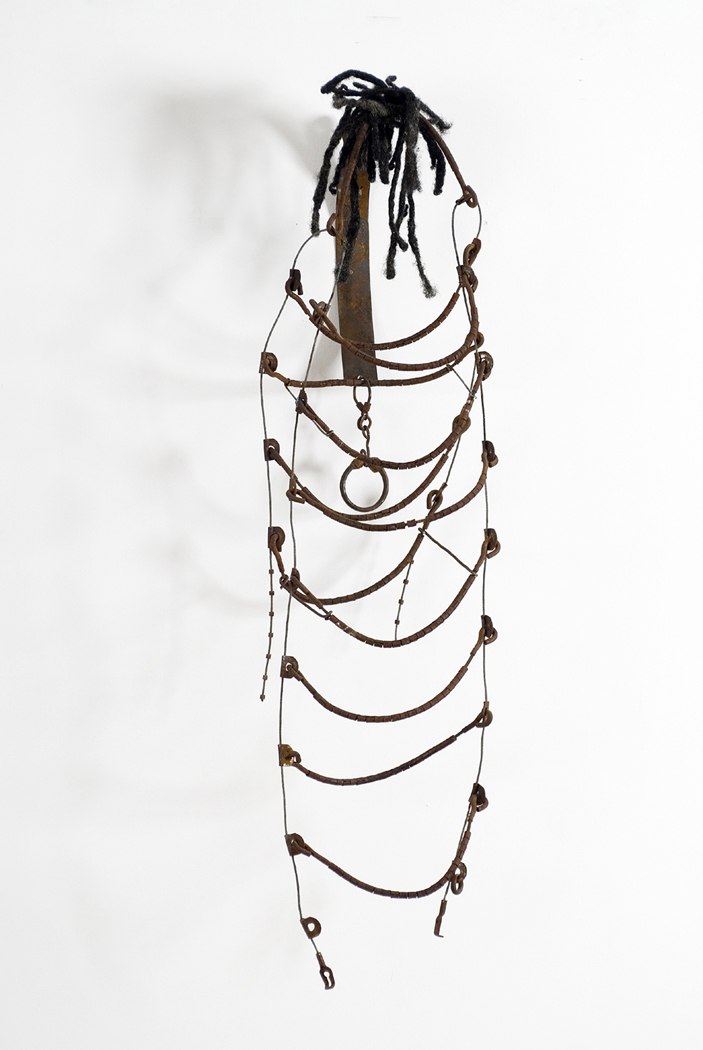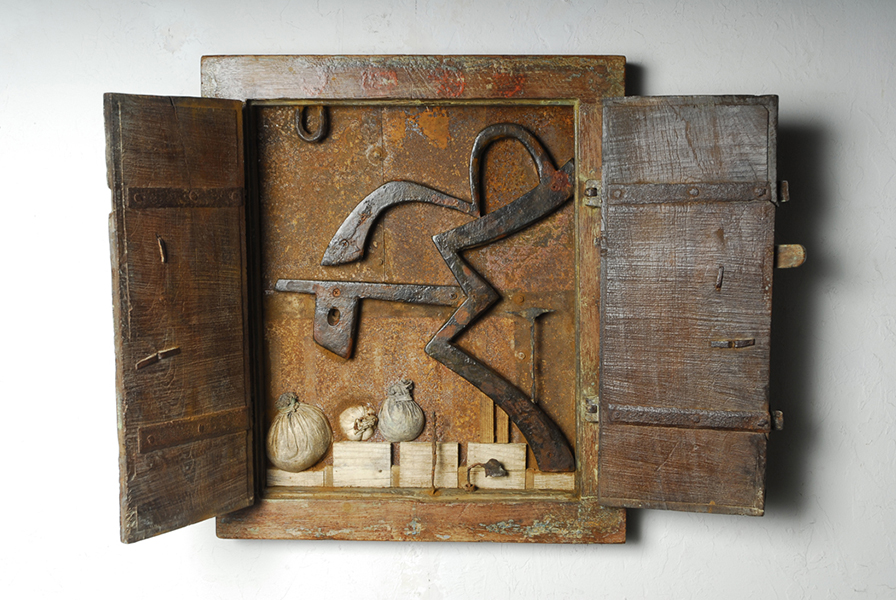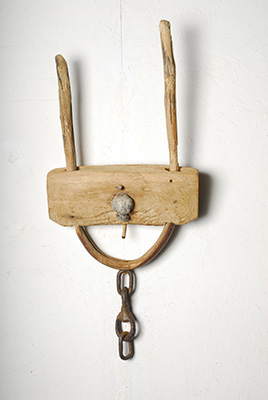
Portrait of Willie, 2008, mixed media, 32 x 9 x 9 inches.

Hinged Window with Asafetida Bags Branded, 2008, mixed media, 20 1/4 x 17 1/4 x 3 1/4 inches.

Asafetida Yoke, 2008, wood, metal, cloth, 30 x 13 1/2 x 3 1/2 inches. Collection of Los Angeles County Museum of Art.
BIOGRAPHY
John Outterbridge is a sculptor and community activist based in Los Angeles. Using found materials such as scrap wood, metal, and glass, he creates poetic objects that draw on assemblage, folk art, and African sculpture. As Director of the Watts Tower Museum, Outterbridge has served as a community leader and mentor to a wide range of artists in Los Angeles. His work has been exhibited at the Centre Pompidou, Paris; Tilton Gallery, New York; California African American Arts Museum, Los Angeles; and others. Outterbridge is a recipient of the J. Paul Getty Fellowship for the Visual Arts (1994), a National Endowment for the Arts Fellowship (1994), a Fullbright Fellowship (1988), among other accolades.
PRESS RELEASE
THE ARTISTS’ LEGACY FOUNDATION AWARDS $25,000 TO JOHN OUTTERBRIDGE
OAKLAND, CALIFORNIA—September 16, 2010—The Artists’ Legacy Foundation is pleased to announce that its fourth annual Artist Award of $25,000 will be given to Los Angeles sculptor John Outterbridge – a renowned artist, ardent community activist, and esteemed arts administrator and teacher. The Artist Award recognizes and honors the accomplishments of an outstanding visual artist whose primary medium is painting or sculpture.
Each year the Artists’ Legacy Foundation asks five nominators, who remain anonymous, to propose two painters or sculptors for the Artist Award. A panel of three jurors reviews artwork of the ten nominees and selects the recipient. This year the Foundation’s jurors were Mildred Howard, artist and teacher; Barbara MacAdam, art critic and deputy editor of ARTnews; and Robert Taplin, sculptor, writer, and teacher. The nominators and jurors are all art world peers, chosen for their expertise.
“John Outterbridge is known as a Los Angeles artist, an integral artist in the history of Assemblage, and a key proponent of a peculiarly American style invoked by jazz music, visual improvisation, and an aesthetics of the cool traceable to the Congo region of Africa,” writes his nominator.
Drawing inspiration from Dada, folk art, and African sculpture, Outterbridge recycles discarded materials, transforming them into poetic configurations that explore both social and political themes. In a career spanning fifty years that began with his seminal role in the Los Angeles assemblage movement of the 1960’s and 70’s, he has succeeded in creating and developing a unique visual language.
“The result,” writes Holland Cotter, “was ‘black art’ that, by and large, avoided stereotypical markers of African-American identity and that was topically loaded without being overtly polemical.” (New York Times, May 12, 2009).
Influenced by Marcel Duchamp, along with contemporaries Mark di Suvero and Robert Rauschenberg, Outterbridge was part of a group of African-American artists, including Betye Saar and David Hammons, who banded together while working in forms of Dada-inspired assemblage at the time of the 1965 Watts uprising; together with sculptor Noah Purifoy, Outterbridge salvaged his media from burned out buildings in the distressed neighborhoods of Watts and South Central.
Born in 1933, in segregated Greenville, North Carolina, Outterbridge credits his father, whose business was collecting and recycling metal machine parts and farm equipment, for teaching him to value discarded materials. He also credits his grandmother for inspiring him with the handcrafted necklaces and beaded pouches (Asafedita bags) she used in her healing practice. For Outterbridge, artifacts made by healers to ward off ailments and ill will, possess a curative and transformative aesthetic power that he aspires to deliver in his own work.
By manipulating found materials, such as broken glass, rusted steel, and hair, Outterbridge excavates personal and cultural histories that have been covered over, neglected, and hidden. Ragged Bar Code (2008), for example, consists of twigs wrapped with rags from LA’s historic garment District, an area known for its sweatshops. In color and texture, the piece alludes to his mother’s quilts, while suggesting, by means of its organic, repetitive forms, that even modernism can be considered a craft. Roberta Smith writes: “Mr. Outterbridge’s Portrait of Willie gets right to the point, brilliantly extracting multiple yet focused meanings from detritus.” (New York Times, December 10, 2009).
His career as an artist began when he moved to Chicago following a three-year stint in the army that earned him the GI bill he needed to go to college. Prior to the army, he had studied engineering for one year at the North Carolina Agricultural and Technical State University. In Chicago he studied painting, first at the Chicago Academy for the Arts (1956 – 59) and then at the American Academy of Art. During this period, he worked as a Chicago Transit Authority bus driver.
In 1963 he moved with his wife to Los Angeles, where he found a job painting in a production studio. The arduous monotony of painting for the production company all day and painting artworks for himself at night, led to his decision to switch mediums. After quitting his day job, he began making sculpture. For two years he worked in his backyard “just building, building, building. I started with stone and worked my way into metal and wood.”
“He was doing fantastic things, as were his friends,” writes Cotter. “But the chance to exhibit in mainstream galleries or museums was practically nil and seemed likely to stay that way. This reality, once he had fully grasped it, intensified his already passionate, principled immersion in community-based collaborations that operated outside market-approved models, redefined the term ‘artist,’ and blurred distinctions between art, education and social action.”
Beginning in 1975, Outterbridge served as Artistic Director of the Compton Communicative Arts Academy, and for 17 years, as Director of the Watts Towers Art Center. In addition to art making, Outterbridge has held the positions of art instructor and fine arts installer at the Pasadena Museum of Art (1967 to 1972). He also taught at the Claremont Colleges, UC Irvine, Cal State Dominguez Hills, and Pasadena City College. Eschewing a conventional art career, writes Cotter, “in recent years [Outterbridge] has built himself a studio and resumed regular production of individual pieces.”
Throughout his career, Outterbridge received numerous awards, including the 1987 National Conference of Arts Educators’ Award; a 1988 Fulbright Fellowship; and, in 1994, a National Endowment for the Arts Fellowship; the J. Paul Getty Fellowship for the Visual Arts; the J.R. Hyde Visiting Artist Fellowship at the Memphis Institute of the Arts; and an honorary doctorate from Otis College of Art and Design.
“That his work is still little known outside of Los Angeles is remarkable,” writes his nominator. “The Artists’ Legacy Foundation award will go towards furthering the knowledge of this vital artist in California and beyond.”
In 2009, Tilton Gallery in New York mounted a solo exhibition of the sculptor’s work. His art has been exhibited in innumerable group shows and was featured in the Pompidou’s Center 2006 groundbreaking exhibition, LosAngeles, 1955-1985: The Birth of an Artistic Capital. His art can also be found in the collections of the California African American Museum and the Los Angeles County Museum of Art.
